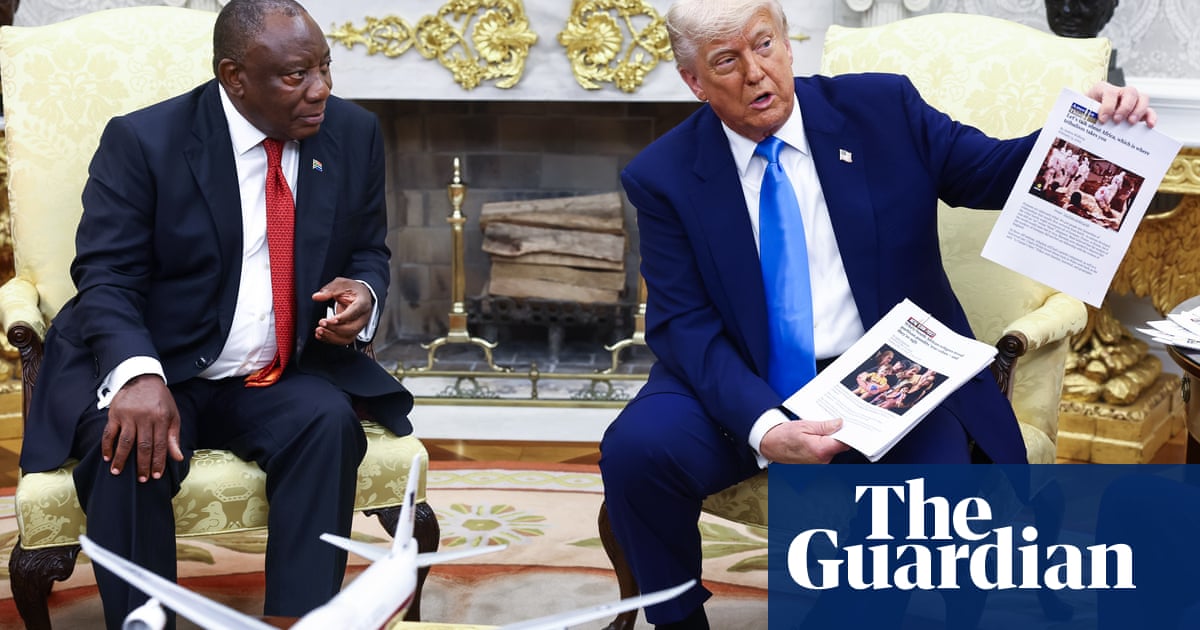The evidence of supposed mass killings of white South Africans presented byDonald Trump in a tense White Housemeeting on Wednesday were in some cases images from the Democratic Republic of Congo, while footage shown during the meeting was falsely portrayed as depicting “burial sites”.
“These are all white farmers that are being buried,” said Trump, holding up a print-out of an article accompanied by a picture during the contentious Oval Office meeting with South African PresidentCyril Ramaphosa.
The picture accompanying the article was in fact a screengrab of a video published by Reuters on 3 February and subsequently verified by the news agency’s fact check team, showing humanitarian workers lifting body bags in the Congolese city of Goma. The image was pulled from Reuters footage shot after deadly battles with Rwanda-backed M23 rebels.
The White House did not respond to a Reuters request for comment.
At another point in the meeting, Trump ambushed Ramaphosa by playing a video that he claimed provedgenocide is being committed against white people in South Africa. Within it was footage that Trump claimed showed the graves of more than a thousand white farmers, marked by white crosses.
The footage – taken at a highway connecting the small towns of Newcastle and Normandein inSouth Africa– in fact showed a memorial site, and not graves.
Rob Hoatson, who set up the memorial to capture public attention,told the BBC it was not a burial site.
“It was a memorial. It was not a permanent memorial that was erected. It was a temporary memorial,” he said. The memorial was setup in the aftermath of a murder of two Afrikaner farmers in the local community.
The video played by Trump on Wednesday contained several falsehoods and inaccuracies, but was intended to back the president’soffer of “refuge” to persecuted white farmers, which has angered the South African government which disputes the allegations. The White House claimed it showed evidence of genocide of white farmers in South Africa. This conspiracy theory, which has circulated among the far-right for years, is based on false claims.
The video prominently featured Julius Malema, a firebrand politician known for his radical rhetoric. He was seen in several clips wearing the red beret of his populist, Marxist-inspired Economic Freedom Fighters (EFF) party and chanting calls to “cut the throat of whiteness” as well as a controversial anti-apartheid song “Kill the Boer, kill the farmer”.
Trump falsely said he was a government official, insinuating his inflammatory slogans reflected an official policy against South Africa’s white minority.
Malema is an opposition politician who gained prominence advocating radical reforms including land redistribution and nationalising key economic sectors.
The party only came fourth in last year’s elections, with 9.5% of the vote. During the Oval Office meeting, Ramaphosa and his delegation distanced themselves from Malema’s rhetoric.
Agriculture minister John Steenhuisen, a member of the centre-right Democratic Alliance, told Trump he joined Ramaphosa’s multiparty coalition “precisely to keep these people out of power”.
Ramaphosa visited Washington this week to try to mend ties with the United States after persistent criticism from Trump in recent months over South Africa’s land laws, foreign policy, and alleged bad treatment of its white minority, which South Africa denies.
With Reuters and Agence France-Presse
